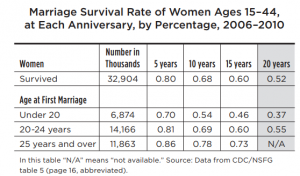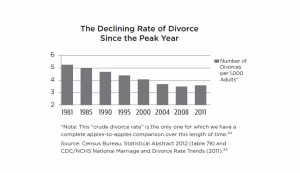The Divorce rate isn’t 50%. Shocking, huh? I know. This is information found in Shaunti Feldhahn and Tally Whitehead’s book, “The Good News About Marriage.” She has made the bold discovery that the actual divorce rate is much lower than 50%. The oversharing of the 50% ratio in media and churches has become discouraging to those who may otherwise choose to get married or to fight harder for the marriages already had.
Shaunti doesn’t want people going into a marriage thinking they only have a 50% percent chance at making the marriage work. Even worse, she doesn’t want couples to choose only to cohabit together in place of marriage because marriage seems harder. The truth is those who cohabit before marriage have a higher rate of divorce (The Truth About Marriage, 2014.)
Of those who have been married to their first spouse, 72% of the couples are still married together in 2009. This means there was a remaining 28% of those who were married to their first spouse who were no longer married in 2009’s Census Data. However, the data doesn’t distinguish between those who aren’t married due to divorce and those who aren’t married due to widowhood.
An assertion was made that the divorce rate in 2009 could have more realistically been around 20% – 25% for first marriages. This is due to an estimate that those couples who are no longer together are not together based on widowhood by between 8-10 percentage points. For all marriages, the divorce rate is estimated to be around thirty-something percent.
If the rate was this low in 2009 and the divorce rate is steadily declining per most recent Census data—the rate has got to be even lower now. (Also see decrease per 1,000 population.) This is largely in part due to people getting married at older ages and the risk for divorce being lower for these marriages. Further, the happiness rate of those married is 80% per a study done by Feldhahn and her team. Of those who had rocky times in marriages they tended to level out within 5 years.
Some who had given up on their marriages said they would have held on had they known that on average the issues they were having would have ended within 5 years. Most who went through with divorce when surveyed did so because they saw no end to the hardship they’d faced in marriage. They’d lost their hope. Hope was mentioned several times over as a determining factor on how well marriages would fare.
The book shares the powerful result of a survey of troubled marriages where 97% of those in the marriage deeply cared for each other. While 59% of those surveyed did not believe their spouse deeply cared. Therefore, for the 59% to get on the same page, some work would be required. The work required to get on the same page isn’t very daunting.
So, where does the 50% divorce rate come from? The book describes a boom in divorce in the 1970s and 1980s by the Baby-boomer generation after the no-fault divorce law was enacted. These were primarily the people who had gotten married very young which has a higher rate of divorce. The book mentions the divorce rate was reported to have gotten up to 48% during this time but has since declined. However, it has been sensational to share the higher divorce rate in media, churches, and blogs alike.
Much of the data with the higher divorce rates do not apply to those who have gotten married more recently as they’ve not been married long enough to have conclusive data. Millennials are getting married at older ages. The average rate of 1st marriage for women at the time of study for the book was 25 or older. The below graph will show that the chance of survival in marriage has increased for those who have been married after the age of 25:
For those who have been married after the age of 25—the data shows a N/A percentage for the survival rate at 20 years as those couples have not been married long enough due to marrying later in life.
There are lots of different bodies of study that Shaunti and her research team took on. She discusses the 50% divorce rate multiple times in the book as a projection of experts. The experts believe that at some point the divorce rate will reach 50% although it hasn’t done so yet. A more accurate account of the divorce rate could be determined by studying the crude divorce rate.
The crude divorce rate is based on actual marriages that took place in varying municipalities compared with divorces. However, this is not just how many were married in a particular year but at any given point and are still married in the municipalities.
The below graph shows the decline in the crude divorce rate over the years:
When researching the divorce rate, see if you can look up what the crude divorce rate is for this time. This was not the only good news. Those who were on their 2nd marriage had a 65% rate of still being with that 2nd spouse. The longer people were together for decades—the greater the likelihood the couple would not divorce.
One of the greatest findings is the fact that the divorce rate in the church is 25-50% lower than those who do not attend worship services. The misbelief that the divorce rate in the church is the same in the world is simply not true. It’s a misquote of a Barna Group Data research study. In the study, the Barna group excluded Christian practices like church attendance and did his study on belief alone. A revised Barna group study accounted for more in-depth questions like weekly church attendance. This study found that the chances of divorce were lower by 25-50%.
Further, a single’s pastor, Dan Chun completed his study. He followed up with 143 couples that he had mentored as singles into the path of marriage. He encouraged them to regularly attend church, meet each other in a healthy environment, keep listening to good teaching, avoid risky decisions like living together before marriage, and stay in a supportive community. Of the hundreds of singles he’s worked with over the years, 143 marriages resulted with only 14 of those marriages resulting in a divorce after the 20-year mark. More can be read about Chun’s study in his book, “How to Pick a Spouse.”
Finally, those who had college degrees had a lower divorce rate as well. In a world where negative news about marriage and divorce is prevalent—it is helpful to read Shaunti’s book, “The Good News About Marriage” for encouragement. This will allow us to have a more positive outlook on our chances of being successful in the institution of marriage.
Shaunti Feldhahn is a Harvard-trained social researcher, popular speaker, and best-selling author of For Women Only and other books with sales of more than two million copies in twenty-two languages. Download the Practical Purity Tips Handout Free at link and consider taking the Top 3 Dating Fears Course below to learn to date successfully:




Leave a Reply